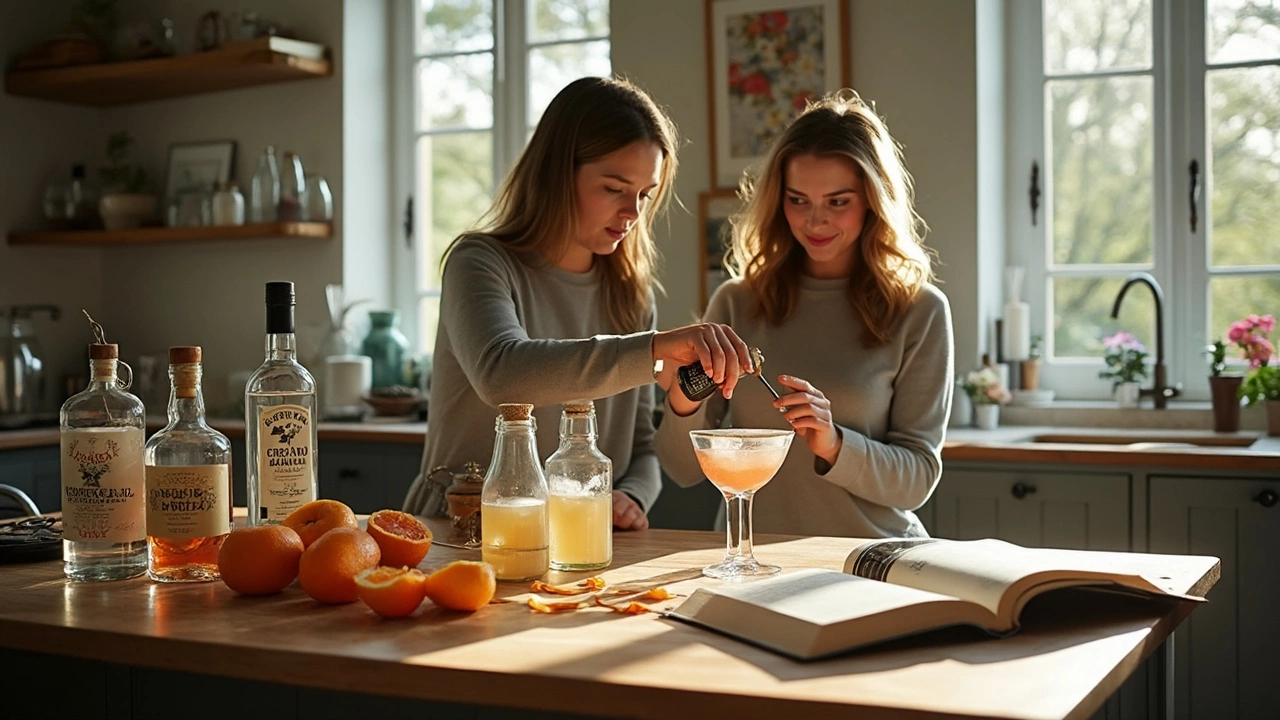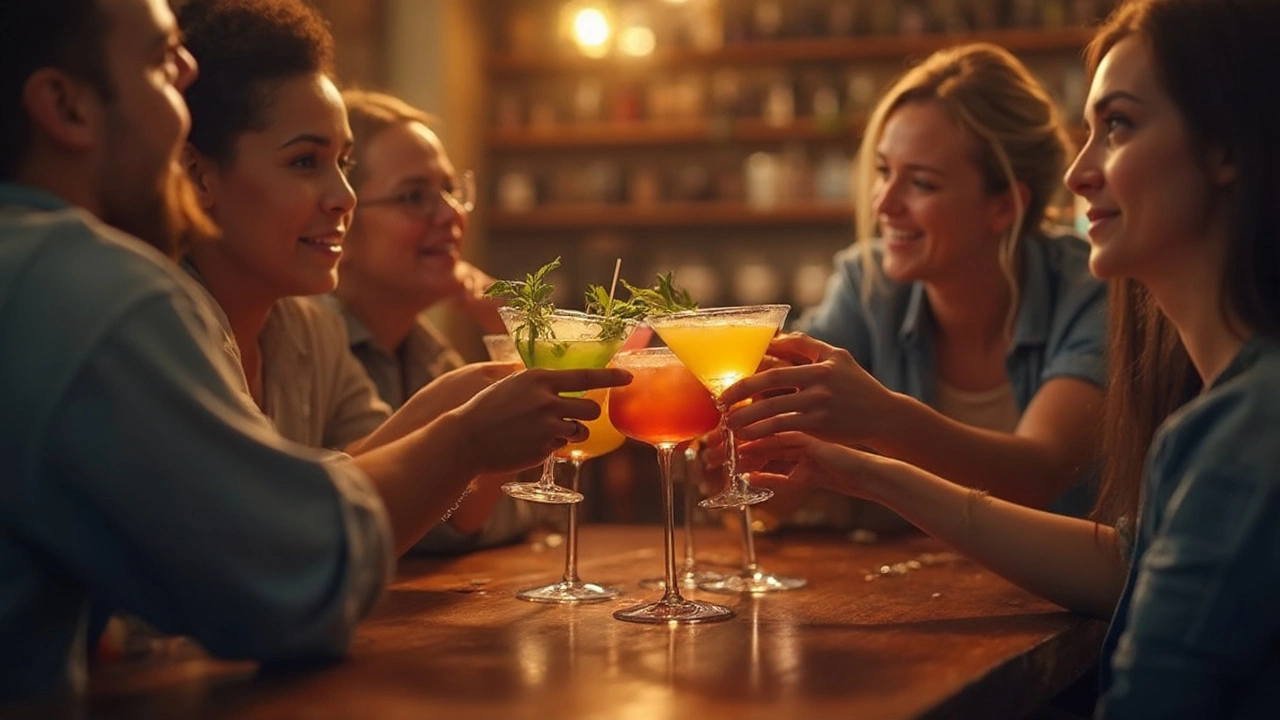Craving a drink doesn't always mean you're after the buzz. Sometimes, it’s the cold glass in your hand, the sense of calm, or just not wanting to feel left out in social settings. That’s why picking an alternative to alcohol isn't only about finding something with zero booze—it's about finding a drink that actually feels like a treat.
If water feels too plain and the same old sodas bore you to tears, you’re in the right place. There’s a whole world of alcohol alternatives that go beyond sparkling water with lime, and they can help you ditch the hangover while still enjoying the ritual. Whether you want something crisp for after work, a punchy mocktail for parties, or just a way to sip socially, there’s a lot out there that tastes good and leaves your head clear the next morning.
Ready to find your go-to? There’s more to the story than just grabbing the first ‘non-alcoholic’ label you see. We’ll break down which options actually work, why some hit the spot more than others, and how switching things up can totally change your night out—or in.
- Why We Crave a Drink in the First Place
- The Top Non-Alcoholic Drinks That Actually Satisfy
- Health and Social Benefits: What Changes When You Switch
- Tips to Make Your Non-Alcoholic Choice Stick
Why We Crave a Drink in the First Place
Let’s be honest: the urge to pour a drink after work or at a party isn’t just random. There's actually a recipe in our brains and routines that makes alcohol feel like the easy choice. But it's not all about wanting to get tipsy. Here’s what science (and shared experience) says is really going on.
First, alcohol lands in the sweet spot for stress relief. When you drink, your brain releases dopamine and endorphins—those are chemicals linked with feeling good and relaxed. It’s the same hit you get from winning a game or getting a compliment, which explains why a cold beer or cocktail can be so appealing at the end of a long day.
Second, we crave the ritual. People love routines, and cracking open a drink is a familiar way to unwind, bond, or signal “me time.” That’s why even when you switch to a best alternative to drinking alcohol, it helps if your drink has a familiar flavor, fizz, or even comes in the right kind of glass.
Feeling included also plays a big role. Research from the American Psychological Association found that nearly 60% of social drinkers said they sipped mainly to avoid feeling left out. In group settings, holding a drink is like holding a ticket to the conversation—it just feels easier to fit in.
Taste and sensory cues matter, too. Alcoholic drinks usually hit the tongue with a balance of sweet, bitter, and sometimes sour. Mocktails and other alternatives work best when they capture that same zing or complexity.
| Reason | Details | Data/Fact |
|---|---|---|
| Stress Relief | Alcohol releases dopamine, reduces tension short-term | Studies show dopamine increases after 1-2 standard drinks |
| Social Ritual | Drinking is seen as a shared activity | 59% of drinkers say they drink to be social (APA, 2022) |
| Habit | People associate drinks with routines (like "wine o'clock") | 55% of Americans report regular weekly drinking pattern |
| Taste | Complex flavors hit different taste receptors | Bitterness and carbonation heavily influence cravings |
So yeah, if you miss the taste, fizz, or even the moment when everyone raises a glass, you’re not weird. That’s how our brains are wired. The trick is finding something else that scratches those same itches—minus the side effects. And that’s why smart alcohol alternatives exist.
The Top Non-Alcoholic Drinks That Actually Satisfy
If you’re ditching booze, you want more than just something wet in your glass. The real winners are drinks that look good, taste bold, and feel like more than just juice with a fancy umbrella. Here’s the lowdown on what’s worth pouring when you want the best alternative to drinking alcohol.
- Non-Alcoholic Beers: Decent non-alcoholic beers have leveled up big time. Brands like Athletic Brewing and Heineken 0.0 taste a lot like the originals. You get hops, fizz, and that "chilled beer" ritual without the risk of texting your ex.
- Zero-Proof Spirits: Ever heard of Seedlip, Ritual, or Lyre's? These are made for folks who crave grownup flavors without the hit. They mix great in classic cocktails or with tonic—think G&Ts that you can drink all evening and still hit the gym in the morning.
- Mocktails Done Right: Forget the sad OJ-and-soda. Mocktails are getting real ingredients and layered flavors now. Stuff like a spicy Virgin Mary, a tangy Nojito, or even a fun espresso tonic stands tall at any gathering.
- Kombucha: A tiny amount of fizz, a bit of tang, and a flavor profile that could pass for something complex. Good brands have between 0.3-0.5% alcohol (barely a blip), loads of probiotics, and way more taste than store-bought soda.
- Sparkling Water with a Twist: Try Sanzo, Spindrift, or even just club soda with a dash of bitters (which usually clocks in at less than a drop of alcohol per serving). Add fresh herbs or citrus for an instant flavor upgrade.
Want the proof that these drinks are catching on? Here’s the data:
| Drink Type | US Sales Growth (2023-2024) | Main Benefit |
|---|---|---|
| Non-Alcoholic Beer | +23% | Closest beer experience; social comfort |
| Zero-Proof Spirits | +40% | Cocktail-friendly, grownup flavors |
| Kombucha | +6% | Gut health, unique taste |
| Mocktails | +32% | Variety, custom taste |
Bottom line: Shops and bars aren’t just tossing out soda anymore. You can get a drink you actually want to finish. Here’s a tip: if you’re at a bar, ask if they have a non-alcoholic or ‘dry’ menu—most decent places do now. At home, play bartender and try mixing your own. You might end up loving it way more than your old favorites.

Health and Social Benefits: What Changes When You Switch
Swapping alcohol for a great best alternative to drinking alcohol does more than save you from a hangover. People usually notice big changes in both body and mind pretty fast after ditching booze.
Your liver gets a break almost right away. Studies show that stopping regular alcohol use for just one month can drop liver fat by up to 20%. You’ll probably sleep better, too—alcohol messes with deep sleep, so don’t be shocked if your energy shoots up after a few nights on the wagon. Another thing people love: fewer headaches, less bloating, and way fewer snack cravings late at night.
| Benefit | What You Might Notice |
|---|---|
| Better Sleep | Less tossing and turning, wake up feeling rested |
| More Energy | No "morning-after" fog, easier to work out or focus |
| Improved Mood | Less anxiety, fewer "Sunday scaries" |
| Weight Loss | Less empty calories, fewer sugar cravings |
| Better Skin | Less redness, fewer breakouts |
Social benefits might surprise you even more. Non-alcoholic drinks keep you 100% clear-headed. That means you’re less likely to say something you regret or get into awkward situations. Plus, you save money – non-alcoholic options usually cost less than cocktails, and you’re not shelling out for Ubers because you can actually drive home. Over time, some folks say they feel more confident in social scenes since they’re not using a drink as a safety net.
And here’s a real tip: at parties or bars, holding a decent alcohol-free drink helps you fit in without needing to explain why you’re not drinking. Many bars in 2025 now stock zero-proof spirits and craft sodas, so skipping alcohol isn’t a big deal anymore. It’s actually pretty common—according to a 2024 survey, 35% of adults aged 21-34 in the US identify as “sober-curious.” That means you’re definitely not the odd one out for ordering something booze-free.
Tips to Make Your Non-Alcoholic Choice Stick
If you want to actually stick with your new drink choice, it’s not just about swapping what’s in your glass. You need some real strategies to keep things interesting—you’re replacing a habit, not just a liquid. Check out these simple moves to level up your experience and avoid backsliding.
- Make It Social: Don’t drink alone, even if it’s a zero-proof drink. Get friends to try new best alternative to drinking alcohol options with you. If you're out, ask your bartender for a creative mocktail instead of settling for lemon water. It feels more intentional.
- Upgrade Your Glassware: Big deal, right? Actually, it is. Pour your kombucha or crafted mocktail into a nice glass. A pretty glass can trick your brain into giving the ritual the same respect as actual booze.
- Experiment with Flavors: Variety is key. Try rotations of botanical sodas, crafted iced teas, or sparkling non-alcoholic wines. Rotate bold, tart, spicy, or herbal notes—find what excites your taste buds and play around until something sticks.
- Know Your Triggers: When are you most likely to want alcohol? Late-night winding down, stressful days, social outings? Prepare your favorite non-alcoholic option ahead of time for those moments, so it’s ready and easy.
- Don't Go it Alone: Account for support. A 2024 meta-study from the American Journal of Public Health showed that people who switched to non-alcoholic alternatives were 50% more successful when family or friends were in on the change.
Need a quick cheat sheet for choosing healthier alternatives? Here’s how some popular picks stack up:
| Drink | Key Benefit | Sugar (per 12oz) | Calories (per 12oz) |
|---|---|---|---|
| Mocktail (homemade) | Customizable, fun | 8g (avg) | 60 |
| Flavored Sparkling Water | Zero sugar, refreshing | 0g | 0 |
| Kombucha | Gut health boost | 6g | 40 |
| Non-Alcoholic Beer | Classic taste, zero buzz | 8g | 70 |
| Crafted Iced Tea | Antioxidants, flavored naturally | 3g | 20 |
Sometimes, the urge for a drink drops off after a week or two of trying something new. Keep a record of what works and don’t be afraid to get creative. Whether it’s social momentum, good flavors, or just feeling better in the morning, locking in your new routine takes a bit of intent—but it pays off quicker than you’d expect.


